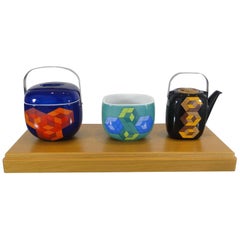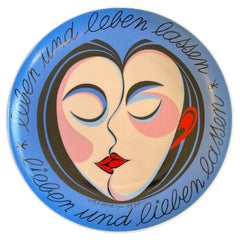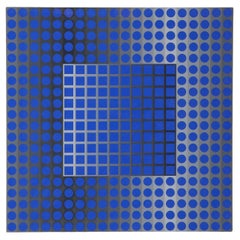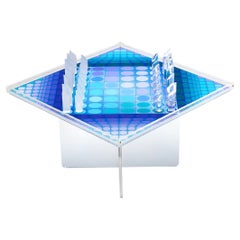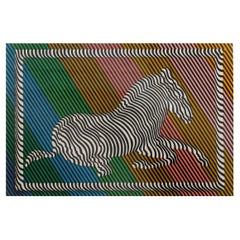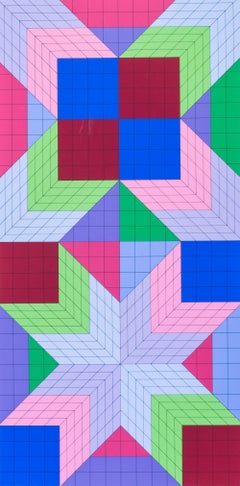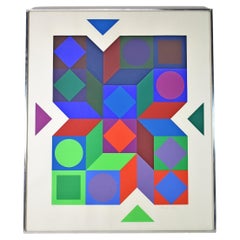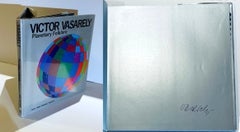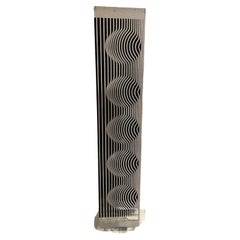Victor Vasarely
Widely considered the grandfather of Op art, the French-Hungarian painter Victor Vasarely (1906–97) created eye-popping geometric abstractions that play with the viewer’s perception of depth, perspective and motion. A classic example is the 1937 Zebra, which consists of undulating black and white stripes that suggest the form of the titular animal through optical trickery. The work is often credited as the earliest Op art painting.
Such illusions were more than pleasing tricks for Vasarely, who insisted that “pure form and pure color can signify the world.” He wanted to “democratize” art by producing works in large editions at reasonable prices that were understandable across national and cultural boundaries. In the 1960s, he developed an alphabet plastique, or fine art alphabet, consisting of elementary visual building blocks that could be used in endless combinations to create original compositions. By employing this universal visual vocabulary and stripping away topical references, he sought to create what he called a “Planetary Folklore.”
Embodying Vasarely’s singular belief that art should serve a social function, accessible to all, these innovations may perhaps be his greatest contribution to 20th-century art.
Find a collection of Victor Vasarely prints, paintings, sculptures and other art on 1stDibs.
| Average Sold Price |
| $14,399 |
| Styles |
| Materials |
| Related Creators |
1970s French Vintage Victor Vasarely
Wood
1980s Hungarian Modern Vintage Victor Vasarely
Acrylic
Mid-20th Century German Mid-Century Modern Victor Vasarely
Porcelain
1990s Swiss Modern Victor Vasarely
Plastic
1980s French Modern Vintage Victor Vasarely
Acrylic
1960s American Modern Vintage Victor Vasarely
Paper
1970s French Post-Modern Vintage Victor Vasarely
Plexiglass
1980s French Modern Vintage Victor Vasarely
Paper
Popular Searches
Victor Vasarely Sellers
Creators Similar to Victor Vasarely
Victor Vasarely furniture for sale on 1stDibs.
- Who is Victor Vasarely?1 Answer1stDibs ExpertMarch 22, 2022Victor Vasarely was a Hungarian-French artist best known for his Op art. By combining principles of geometry with artistic techniques, he produced two-dimensional works with incredible depth. Some even seem to move on the canvas. Vasarely also made sculptures, collages and decorative accents. On 1stDibs, shop a variety of Victor Vasarely art.
- Where is Victor Vasarely from?1 Answer1stDibs ExpertMarch 22, 2022Victor Vasarely was originally from Hungary. He was born in Pécs on April 9, 1906. His family moved to Piešťany, Slovakia, during his childhood, and he attended medical and art schools in Budapest, Hungary. In 1930, Vasarely relocated to Paris, France, and lived there until his death on March 15, 1997. On 1stDibs, find a variety of Victor Vasarely art.
- When was Victor Vasarely born?1 Answer1stDibs ExpertMarch 22, 2022Victor Vasarely was born in Pécs, Hungary, on April 9, 1906. Over the course of his life, he lived in Piešťany, Slovakia; Budapest, Hungary; and Paris, France. He died in Paris on March 15, 1997. On 1stDibs, find a selection of Victor Vasarely art.
- 1stDibs ExpertMarch 22, 2022To pronounce Victor Vasarely, say "VIK-tr va-sr-EH-lee." His first name and surname are Hungarian. The artist, known as one of the pioneers of Op art, was born in Pécs, Hungary, on April 9, 1906. Find a variety of Victor Vasarely art on 1stDibs.
- 1stDibs ExpertApril 5, 2022Victor Vasarely's famous painting Zebra is on display at the Pompidou Centre in Paris, France. He painted the piece in 1937. You can see elements of the Op art style that Vasarely would later become famous for taking shape in the painting. On 1stDibs, find a range of Victor Vasarely art.
- What inspired Victor Vasarely?1 Answer1stDibs ExpertMarch 22, 2022Many things inspired Victor Vasarely over the course of his life. The color theory of Josef Albers, and the Constructivist methods of Wassily Kandinsky greatly influenced his work. He also found inspiration in the geometry of the natural world, particularly in the landscapes of Breton Beach of Belle Isle in France. On 1stDibs, find a selection of Victor Vasarely art.
- 1stDibs ExpertFebruary 13, 2024One key fact about Victor Vasarely is that he is considered the grandfather of Op art due to his eye-popping geometric abstractions that play with the viewer’s perception of depth, perspective and motion. He was born in Pécs, Austria-Hungary, on April 9, 1906, and began studying medicine at the Eötvös Loránd University in 1925 with the hope of one day becoming a doctor. Two years later, he shifted gears and enrolled in a painting course at the Podolini-Volkmann Academy. In the 1960s, he developed an alphabet plastique, or fine art alphabet, consisting of elementary visual building blocks that could be used in endless combinations to create original compositions. One final fact is that both Hungary and France have issued postage stamps featuring his artwork. On 1stDibs, explore a range of Victor Vasarely art.
- 1stDibs ExpertApril 5, 2022Victor Vasarely was an artist, working in painting, sculptures and collages. His vibrant, geometric pieces earned him the nickname of ‘grandfather’ of the Op Art movement. Shop a selection of Victor Vasarely’s pieces from some of the world’s top art dealers on 1stDibs.
- 1stDibs ExpertApril 22, 2024Here are some facts about Victor Vasarely's art. First, his work contributed to the development of Op art and consisted largely of eye-popping geometric abstractions that play with the viewer's perception of depth, perspective and motion. A classic example is the 1937 Zebra, which consists of undulating black and white stripes that suggest the form of the titular animal through optical trickery. The work is often credited as the earliest Op art painting. Vasarely wasn't just attempting to fool the eye; he wanted to "democratize" art by producing work in large editions at reasonable prices and with themes that were understandable across national and cultural boundaries. Also, Vasarely developed an alphabet plastique, or fine art alphabet, consisting of elementary visual building blocks that could be used in endless combinations to create original compositions. By employing this universal visual vocabulary and stripping away topical references, he sought to create what he called a "Planetary Folklore." On 1stDibs, shop a selection of Victor Vasarely art.
- 1stDibs ExpertMarch 22, 2022Yes, Victor Vasarely was an abstract artist. Specifically, he was a part of the Op art movement, which focused on depicting two-dimensional abstract images that appear three-dimensional. His best known works include Zebras, Tridim, Vega-Nor, Denfert and Cheyt-M. Find a collection of Victor Vasarely art on 1stDibs.
- 1stDibs ExpertMarch 22, 2022Many historians identify Zebras as Victor Vasarely's most famous piece. He painted the work in 1937. Some of his most famous Op art compositions include Tridim, Vega-Nor, Denfert and Cheyt-M. On 1stDibs, find a range of Victor Vasarely art.
- 1stDibs ExpertMarch 22, 2022Victor Vasarely used a variety of materials to produce his art. He painted with both oils and acrylics and usually used canvas as the base of his works. Many of his sculptures feature lucite and glass. On 1stDibs, find a collection of Victor Vasarely art.
- 1stDibs ExpertFebruary 1, 2024Victor Vasarely is best known for producing sculptures and paintings with a grid-like appearance. The Hungarian-French artist first began to create these works in 1960, aiming to play with how viewers perceive depth and form. These works demonstrated that kinetic art could be two-dimensional and evoke a sense of movement despite remaining stationary. On 1stDibs, find a selection of Victor Vasarely art.
- 1stDibs ExpertFebruary 21, 2024The name of one of the most well-known artworks by Victor Vasarely is Zebra. He produced the piece in 1937, and it depicts two zebras with bold black stripes that seem to undulate before the eye. Other acclaimed works by the Hungarian-French artist include Vega-Nor, Tekers MC, Keple-Gestalt, The Chess Board, Vonal-Stri, Vega 200 and Orion Gris. Explore a collection of Victor Vasarely art on 1stDibs.
- 1stDibs ExpertApril 5, 2024How Victor Vasarely created his art varied. For his paintings, the Op artist typically used canvas as a base, painstakingly adding geometric forms in oil and acrylic paint. When producing sculptures, Vasarely often used lucite and glass to give his works a feeling of depth and luminosity. On 1stDibs, find a variety of Victor Vasarely art.
- 1stDibs ExpertMarch 13, 2024There are many examples of Op art by Victor Vasarely, who is widely considered the grandfather of this art movement. A classic example is 1937’s Zebra, which has undulating black and white stripes that suggest the form of the titular animal through optical trickery. The work is often credited as the earliest Op art painting. Other Op art works by Vasarely include Vega-Nor, The Chess Board, Vonal-Stri and Keple-Gestalt. Shop a range of Victor Vasarely art on 1stDibs.
- 1stDibs ExpertMarch 22, 2022The exact number of paintings Victor Vasarely painted is unknown. However, historians know of more than 1,000 works produced by the artist over the course of his life. In addition to paintings, he produced sculptures, collages and decorative objects. On 1stDibs, shop a range of Victor Vasarely art.
- 1stDibs ExpertMarch 22, 2022Victor Vasarely produced Op art by employing principles of physics and geometry. He painted his works by hand with oils and acrylics on canvas in a way that made the images seem three-dimensional and capable of movement. On 1stDibs, shop a selection of Victor Vasarely art.
- 1stDibs ExpertMarch 22, 2022The exact number of artworks produced by Victor Vasarely is unknown. However, references include more than 1,000 pieces attributed to the Hungarian-French artist. Vasarely shaped the Op art movement with pieces like Tridim, Vega-Noir and Cheyt-M. On 1stDibs, shop a selection of Victor Vasarely art.
- 1stDibs ExpertApril 5, 2022Victor Vasarely made 44 works of art in his lifetime. The artist’s paintings fell into the Op-Art movement and his work entitled Zebra is considered one of the earliest examples of Op-Art. His paintings often focus on bold colors, shading, shapes and optical illusions. Shop a selection of Vasarely pieces from some of the world’s top art dealers on 1stDibs.
